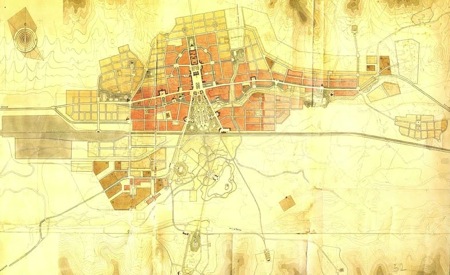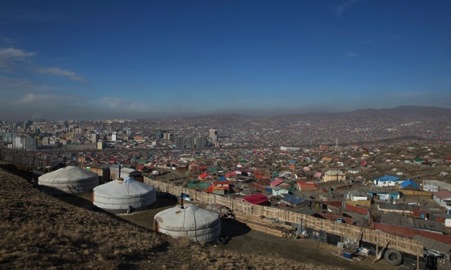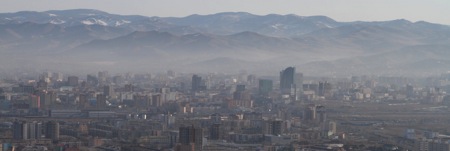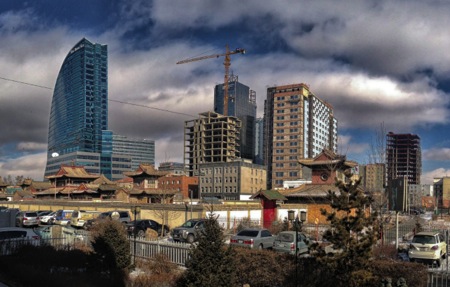This is the first part in a two part series focusing on the importance of Urban Planning and its relevance to Ulaanbaatar. This first part will provide an overview of the challenges the city faces. The second will offer an insight into what is being done to combat the challenges and what further measures could be undertaken.
Urban Planning is the practice famously defined by Frederick Law Olmstead Jr. as the "intelligent control or guidance of the physical form of the city, in its entirety"; this entails taking account of the past, present and future trajectory of a city’s development and in turn making informed decisions about what should and should not be part of the cityscape. Good Urban Planning can help to solve large problems and lead to the creation of cities that have a direct impact on the lives of its citizens for example, cities like London, Amsterdam and New York have all gone though stages in which they faced development challenges that range from pollution, flooding and population influx. Nevertheless, these are all now cities of world-renown, largely due to the fact these municipalities were steered in the right direction by urban planners allowing them to become the livable, successful cities they are today.
 The importance of Urban Planning as a practice is ever growing with the face of the planet changing at break-neck speeds. Today is the first period in human history in which more people live in cities than they do in rural areas making the city’s significance to
The importance of Urban Planning as a practice is ever growing with the face of the planet changing at break-neck speeds. Today is the first period in human history in which more people live in cities than they do in rural areas making the city’s significance to
life on Earth all the more important. Such a vast change when coupled with globalization, climate change, resource scarcity and even the recent financial crisis emphasize the importance of good urban planning. The right urban environment can nurture environmental, economic and social growth allowing a city and even a country to flourish.
The relevance of this profession to the city of Ulaanbaatar cannot be over emphasized, as with the cities mentioned previously, this is a young city early in its development stages that is facing a number of obstacles like population growth, pollution, failures in infrastructure, social inclusion and the problem of governance. What is important to remember when reviewing these concerns is the fact that these are all problems that have previously been faced in many other places, yet, have been solved through effective Urban Planning. Before we continue discussing the issues that face Ulaanbaatar, one must remember these are highly complex issues that will not be solved overnight – advisors and onlookers must be patient and remember the urban fabric of this city is young. Many other cities took significantly longer to reach even where UB is today.
 Rapid population growth appears to be the key driver to all of the urban challenges faced by Ulaanbaatar today. According to UNdata the population of the city in 2003 was 893,437 and in 2010 was estimated to be around 1,132,000; this is a very significant change in under a decade. The effect of this swift growth on the city is something that is worsened by the fact that Ulaanbaatar’s urban framework was only initially supposed to support a much smaller population – on initial Soviet plans figures as low as around 400,000 inhabitants are often cited as being the number the city was first created to host. This minimal figure will have changed over the life of the city, nevertheless, urban planning has faced many challenges since the fall of the communist system in the early 1990s; it is now slowly starting to find its way again.
Rapid population growth appears to be the key driver to all of the urban challenges faced by Ulaanbaatar today. According to UNdata the population of the city in 2003 was 893,437 and in 2010 was estimated to be around 1,132,000; this is a very significant change in under a decade. The effect of this swift growth on the city is something that is worsened by the fact that Ulaanbaatar’s urban framework was only initially supposed to support a much smaller population – on initial Soviet plans figures as low as around 400,000 inhabitants are often cited as being the number the city was first created to host. This minimal figure will have changed over the life of the city, nevertheless, urban planning has faced many challenges since the fall of the communist system in the early 1990s; it is now slowly starting to find its way again.
The big driver of the city’s population growth is inward migration to the Ger Districts generally due to a combination of rural hardship caused by geographic events and the search for a better quality of life. Currently 60% of UB’s population lives in these informal areas, which are estimated to grow at a rate of 40,000 people per year. The rapid growth of this area is a large contributing factor in causing the suffocating winter pollution and a rising strain on the city’s aging infrastructure in particular with a rise in public transport usage and an overall escalation in traffic. Having said this though, the Ger District is an area that will hold much of Ulaanbaatar’s future opportunities, as well as its challenges.
In a recent study, it was found that Ulaanbaatar is the most polluted city in the world in terms of the Particulate Matter (PM) index, based upon a study by Prof. Lodoysamba of the National University of Mongolia. This pollution is heavily down to the Ger District residents who burn coal and anything else that will help to keep them warm in the frigid winter with an average temperature of -20oC. Such pollution would conceivably be much lower if the Ger District residents had access to the heating infrastructure system with energy generated in a power plant, as a large scale power station is much more efficient than thousands of small coal and wood burners. Pollution, it must be stressed, is not only caused by Ger District residents but also from UB’s coal burning power stations, wind blown dust, and finally, private and public transport with the number of vehicles in Ulaanbaatar increasing from 75,000 to over 300,000 between 2005 to 2013. The effects of pollution are further aggravated when Ulaanbaatar’s geographic make up are taken into account as the mountains surrounding the city stop the smog from escaping further worsening the situation.

The next big challenge faced by the city of Ulaanbaatar is that of infrastructure – only around 50% of Ulaanbaatar residents have permanent access to some form of infrastructure such as heating, electricity and running water. With growth in both formal and informal buildings, pressure is mounting on all areas of the infrastructure network; much of which was built during the Soviet era when there was much lower energy demand. At present pressure comes in many forms, whether it is electricity being used in construction sites of high-end residential property, an office building or for a Ger’s lighting system, with more and more actors tapping into the grid the burden on the power system is mounting and the number of power cuts is increasing year on year.
There is a similar picture if one looks at water supply, as highlighted in a recent study carried out by the World Health Organisation, it is estimated that there are 74 possible risks facing the nation’s drinking water sources, stating a number of threats including illegal construction sites, mining and human interference all of which are exacerbated when combined with poor water treatment facilities, outdoor toilets and pollution. It must once again be remembered that the aforementioned problems are solvable, yet highly challenging in Mongolia due to this country’s very specific geographic, meteorological and socio-economic make-up. Only good urban planning and, vitally, its enforcement will help to resolve such wide spread concerns, something that should not be taken lightly.
One area of the urban fabric that often appears to be over looked is social inclusion. The World Bank defines social inclusion as the process of improving the terms of individuals and groups to take part in society, arguing that poverty alone is not a comprehensive maker of deprivation; in their list of various other drivers of poverty is place of residence. In the case of residents of the Ger district this may mean being deprived of access to schooling, hospitals or other social amenities like libraries. This exclusion is most probably due to the location of an individual’s home, creating barriers to social progress and in turn the wider development of society. It is possible to argue such exclusion is also going to have the further effect of engineering prejudice due to lack of interaction between the residents of one area and another.

Governance is the final hurdle facing the city of UB, impacting all others previously mentioned. A city can have the best Master Plan in the world, however, if it does not stick to the plan and enforce laws it cannot make progress. This applies to making sure buildings are allocated in areas they are needed and are constructed to a good standard. It ironically means observing what is needed in the market and making sure it is built – a partially planned system as opposed to a true free market system. Take for instance the fact that Ulaanbaatar is awash with high-end residential apartments that are unaffordable for the large proportion of people; in a city that so desperately needs affordable housing. If developers were controlled and were not allowed to build whatever and wherever they wanted it would save precious resources and allow such resources to be allocated to other areas of the city, one can speculate it could even make the cost of development lower as there would be a depressed demand for land, labour, and capital. Such practices are commonplace in many other places and without enforcement of overarching plans and codes progress will not be made.
One can observe that there are a great number of challenges facing the city of Ulaanbaatar whether they are man-made or geographical, nonetheless, there is considerable potential for the future of the city depending on how the aforementioned challenges are addressed. The next article will provide an overview of the current solutions being implemented in Ulaanbaatar and will try to look to other cities and examples for alternative solutions.
This is the first part in a two part series focusing on the importance of Urban Planning and its relevance to Ulaanbaatar. This first part will provide an overview of the challenges the city faces. The second will offer an insight into what is being done to combat the challenges and what further measures could be undertaken.
Urban Planning is the practice famously defined by Frederick Law Olmstead Jr. as the "intelligent control or guidance of the physical form of the city, in its entirety"; this entails taking account of the past, present and future trajectory of a city’s development and in turn making informed decisions about what should and should not be part of the cityscape. Good Urban Planning can help to solve large problems and lead to the creation of cities that have a direct impact on the lives of its citizens for example, cities like London, Amsterdam and New York have all gone though stages in which they faced development challenges that range from pollution, flooding and population influx. Nevertheless, these are all now cities of world-renown, largely due to the fact these municipalities were steered in the right direction by urban planners allowing them to become the livable, successful cities they are today.
 The importance of Urban Planning as a practice is ever growing with the face of the planet changing at break-neck speeds. Today is the first period in human history in which more people live in cities than they do in rural areas making the city’s significance to
The importance of Urban Planning as a practice is ever growing with the face of the planet changing at break-neck speeds. Today is the first period in human history in which more people live in cities than they do in rural areas making the city’s significance to
life on Earth all the more important. Such a vast change when coupled with globalization, climate change, resource scarcity and even the recent financial crisis emphasize the importance of good urban planning. The right urban environment can nurture environmental, economic and social growth allowing a city and even a country to flourish.
The relevance of this profession to the city of Ulaanbaatar cannot be over emphasized, as with the cities mentioned previously, this is a young city early in its development stages that is facing a number of obstacles like population growth, pollution, failures in infrastructure, social inclusion and the problem of governance. What is important to remember when reviewing these concerns is the fact that these are all problems that have previously been faced in many other places, yet, have been solved through effective Urban Planning. Before we continue discussing the issues that face Ulaanbaatar, one must remember these are highly complex issues that will not be solved overnight – advisors and onlookers must be patient and remember the urban fabric of this city is young. Many other cities took significantly longer to reach even where UB is today.
 Rapid population growth appears to be the key driver to all of the urban challenges faced by Ulaanbaatar today. According to UNdata the population of the city in 2003 was 893,437 and in 2010 was estimated to be around 1,132,000; this is a very significant change in under a decade. The effect of this swift growth on the city is something that is worsened by the fact that Ulaanbaatar’s urban framework was only initially supposed to support a much smaller population – on initial Soviet plans figures as low as around 400,000 inhabitants are often cited as being the number the city was first created to host. This minimal figure will have changed over the life of the city, nevertheless, urban planning has faced many challenges since the fall of the communist system in the early 1990s; it is now slowly starting to find its way again.
Rapid population growth appears to be the key driver to all of the urban challenges faced by Ulaanbaatar today. According to UNdata the population of the city in 2003 was 893,437 and in 2010 was estimated to be around 1,132,000; this is a very significant change in under a decade. The effect of this swift growth on the city is something that is worsened by the fact that Ulaanbaatar’s urban framework was only initially supposed to support a much smaller population – on initial Soviet plans figures as low as around 400,000 inhabitants are often cited as being the number the city was first created to host. This minimal figure will have changed over the life of the city, nevertheless, urban planning has faced many challenges since the fall of the communist system in the early 1990s; it is now slowly starting to find its way again.
The big driver of the city’s population growth is inward migration to the Ger Districts generally due to a combination of rural hardship caused by geographic events and the search for a better quality of life. Currently 60% of UB’s population lives in these informal areas, which are estimated to grow at a rate of 40,000 people per year. The rapid growth of this area is a large contributing factor in causing the suffocating winter pollution and a rising strain on the city’s aging infrastructure in particular with a rise in public transport usage and an overall escalation in traffic. Having said this though, the Ger District is an area that will hold much of Ulaanbaatar’s future opportunities, as well as its challenges.
In a recent study, it was found that Ulaanbaatar is the most polluted city in the world in terms of the Particulate Matter (PM) index, based upon a study by Prof. Lodoysamba of the National University of Mongolia. This pollution is heavily down to the Ger District residents who burn coal and anything else that will help to keep them warm in the frigid winter with an average temperature of -20oC. Such pollution would conceivably be much lower if the Ger District residents had access to the heating infrastructure system with energy generated in a power plant, as a large scale power station is much more efficient than thousands of small coal and wood burners. Pollution, it must be stressed, is not only caused by Ger District residents but also from UB’s coal burning power stations, wind blown dust, and finally, private and public transport with the number of vehicles in Ulaanbaatar increasing from 75,000 to over 300,000 between 2005 to 2013. The effects of pollution are further aggravated when Ulaanbaatar’s geographic make up are taken into account as the mountains surrounding the city stop the smog from escaping further worsening the situation.

The next big challenge faced by the city of Ulaanbaatar is that of infrastructure – only around 50% of Ulaanbaatar residents have permanent access to some form of infrastructure such as heating, electricity and running water. With growth in both formal and informal buildings, pressure is mounting on all areas of the infrastructure network; much of which was built during the Soviet era when there was much lower energy demand. At present pressure comes in many forms, whether it is electricity being used in construction sites of high-end residential property, an office building or for a Ger’s lighting system, with more and more actors tapping into the grid the burden on the power system is mounting and the number of power cuts is increasing year on year.
There is a similar picture if one looks at water supply, as highlighted in a recent study carried out by the World Health Organisation, it is estimated that there are 74 possible risks facing the nation’s drinking water sources, stating a number of threats including illegal construction sites, mining and human interference all of which are exacerbated when combined with poor water treatment facilities, outdoor toilets and pollution. It must once again be remembered that the aforementioned problems are solvable, yet highly challenging in Mongolia due to this country’s very specific geographic, meteorological and socio-economic make-up. Only good urban planning and, vitally, its enforcement will help to resolve such wide spread concerns, something that should not be taken lightly.
One area of the urban fabric that often appears to be over looked is social inclusion. The World Bank defines social inclusion as the process of improving the terms of individuals and groups to take part in society, arguing that poverty alone is not a comprehensive maker of deprivation; in their list of various other drivers of poverty is place of residence. In the case of residents of the Ger district this may mean being deprived of access to schooling, hospitals or other social amenities like libraries. This exclusion is most probably due to the location of an individual’s home, creating barriers to social progress and in turn the wider development of society. It is possible to argue such exclusion is also going to have the further effect of engineering prejudice due to lack of interaction between the residents of one area and another.

Governance is the final hurdle facing the city of UB, impacting all others previously mentioned. A city can have the best Master Plan in the world, however, if it does not stick to the plan and enforce laws it cannot make progress. This applies to making sure buildings are allocated in areas they are needed and are constructed to a good standard. It ironically means observing what is needed in the market and making sure it is built – a partially planned system as opposed to a true free market system. Take for instance the fact that Ulaanbaatar is awash with high-end residential apartments that are unaffordable for the large proportion of people; in a city that so desperately needs affordable housing. If developers were controlled and were not allowed to build whatever and wherever they wanted it would save precious resources and allow such resources to be allocated to other areas of the city, one can speculate it could even make the cost of development lower as there would be a depressed demand for land, labour, and capital. Such practices are commonplace in many other places and without enforcement of overarching plans and codes progress will not be made.
One can observe that there are a great number of challenges facing the city of Ulaanbaatar whether they are man-made or geographical, nonetheless, there is considerable potential for the future of the city depending on how the aforementioned challenges are addressed. The next article will provide an overview of the current solutions being implemented in Ulaanbaatar and will try to look to other cities and examples for alternative solutions.
